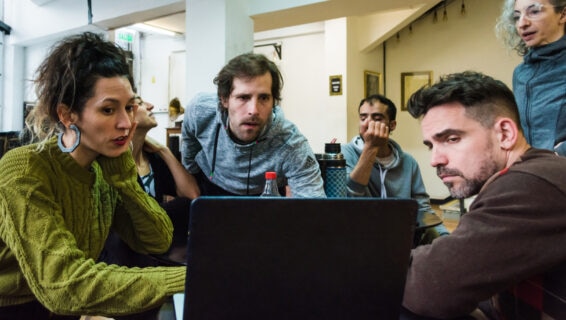
How to make meetings more productive
Table of Contents
- Reduce meetings
- Work out if a meeting is necessary
- Steps to improving meeting productivity
- The importance of boosting meeting productivity
Discover strategies to make your workplace meetings more productive and save valuable time, money and brain power.
Maybe you attend meetings where the aims are unclear and you leave feeling like little is resolved. Or maybe someone in your team is struggling to juggle the amount of time spent in meetings with their workload. Either way, reassessing the purpose, process and results of meetings benefits productivity, sidesteps distractions and helps staff become more engaged. In this guide, we’ll examine how you can maximise the efficiency of your meetings. Let’s dive in.
Reduce meetings
The first step to having more effective meetings at work is to try to reduce the overall number of meetings that employees are having. This helps to focus minds on what really matters. If there is a general policy of not setting meetings for things that can be communicated by email, for example, employees will no longer be setting up that Teams meeting as the first point of call. Instead, they will consider whether the meeting needs to happen at all. This is important, as a recent survey shows that 65% of workers feel panicked as calendars stretch to take on more meetings than ever.
No meetings Friday
Depending on your organisational and team needs, you may even be able to implement a ‘no meetings’ rule on certain days of the week. Some organisations like to do this on Fridays. This can help to cut down the overall number of meetings, leaving the day free for workers to have real focus time without having to take time out to attend weekly meetings.
Work out if a meeting is necessary
Many meetings can have the same result as sharing an email or sending messages on Slack or Teams. In order to optimise yours and your colleagues’ time at work, it can be useful to think about the below factors when deciding whether a meeting is really required.
What questions need answering?
This should be the first port of call when deciding whether a meeting is required. The more ground you need to cover, the more likely a meeting is the most efficient approach. Otherwise, you might have an email back and forth over the course of some hours or even days, when all the questions, and follow-up questions, could be dealt with in one go.
Who will be able to answer your question(s)?
If you need input from multiple people, email chains can quickly get confusing, or people can start missing things. So, a meeting might make it easier to get multiple stakeholders’ perspectives if that is what is required.
Do you need creative input?
Often, when talking about visuals or creative solutions, getting a group of people together aids problem-solving and lets people bounce ideas off each other. It also gives people the chance to absorb each others’ viewpoints, which can lead to better results when brainstorming or giving feedback.
Steps to improving meeting productivity
Once it’s been decided a meeting is required to overcome a particular challenge, answer a question or get team members aligned on a project, you need to take steps to ensure that you can achieve the desired outcome and make it a good use of both time and resources. Below, we’ve outlined some of the strategies you can implement to get the most out of your workplace meetings.
1. Set an agenda
If a meeting’s the way to go, establish a firm agenda beforehand – and stick to it. Include each agenda item on the invite so meeting participants know what to expect and what’s needed from them. You can even write your overarching goal down on a whiteboard or notepad at the beginning of the session, so you keep on track. If you drift off-topic, it will become obvious immediately thanks to this visual cue. Example meeting agenda A meeting agenda can be very short and to the point. Here’s what one for a design team could look like this:
- Welcome and intros (2 minutes)
- Overview of new client brief (5 minutes)
- Key project requirements and deadlines (3 minutes)
- Initial design concepts brainstorming (10 minutes)
- Next steps (5 minutes)
- Questions (5 minutes)
2. Give attendees a chance to prepare
Make sure everyone has time to prepare for your meeting. You can send any relevant documents to help contextualise the meeting beforehand. This ensures attendees are all starting on the same page for maximum productivity and time isn’t spent quietly reading during the meeting itself. If you want to drive a discussion, people may need a chance to digest the topic before steaming straight into this or coming up with resolutions.
3. Start on time
Make a point that the meeting commences at a set time – that time is not when people should get up from their desks and make the walk to a meeting room, or dial into a call. They should be seated in the meeting room when the meeting starts, not arriving then.
4. Consider taking meeting notes
While taking notes can be a potential distraction during meetings, it can help to boost productivity as the important information and action items will be noted down and can then be shared afterwards. You could nominate one person to be the note taker, and they can focus on taking brief notes of the key topics discussed and decisions made. Assigning this task to one person means anyone else in the meeting can focus on the task at hand, whether that’s giving a presentation, having a discussion or debate, or asking and answering questions. Give different members of the team this responsibility in future meetings so the note-taking is shared. If you end up recording the meeting, this can be a chance to harness generative AI by feeding the recording into the AI and getting it to produce a summary in a matter of seconds.
5. Maintain focus and cut out distraction
Encourage your team to highlight off-topic comments or tangents to ensure you get back to the task at hand. Alternatively, the organiser of the meeting can lead on this. Essentially, meetings are more productive when the attendees stick to the agenda and save unrelated talk for a coffee break. On the other hand, meetings can also be a good time to get some face-to-face time between team members, so it’s a good idea to balance just how strict you’ll be on this.
6. Take breaks
If you’re in for an afternoon filled to the brim with idea-generating and problem-solving, schedule in breaks. Keeping focused and on-task is impossible if there’s no chance for brains to check out and return refreshed and ready to tackle the task at hand. This is also crucial for letting information be absorbed, without overloading attendees. Breaks also allow plenty of time for catch-ups between team members, which can then be left at the door when the meeting kicks off again.
7. Mix up the length of meetings
Research from Nicole Steinbok suggests that the typical 30- or 60-minute meeting is an arbitrary amount of time. We assume we need a rounded length of time to have a successful meeting that works through a problem or discusses a strategy. However, we rarely need this, according to Steinbok. Try scheduling meetings for 22 minutes in line with her recommendations and see if you can get just as much done in that time as you can in 30 minutes or more.
8. Give attendees a chance to speak
Meetings can certainly be more productive if the agenda is rigidly stuck to, but that can often be passing over an opportunity to let the attendees speak up, whether that’s to give new ideas or feedback.
This can be a step towards creating a culture of active listening and encouraging employee voice. It can also mean that new ideas from potentially junior members of staff get to be aired at the same time, rather than scheduling new meetings for this. It could also go some ways to promoting team building and collaboration within your organisation.
The importance of boosting meeting productivity
Understanding how to make meetings more productive, and putting proven strategies into action, is vital to increase the efficiency of any workplace. By reducing the number of meetings, implementing ‘no meeting’ days, and carefully considering whether a gathering is necessary, teams can reclaim valuable time. When meetings are essential, clear agendas, punctuality, and focused discussions are key. Encouraging preparation, minimising distractions, and assigning note-taking duties can increase their effectiveness. Remember to give employees enough break time to stay refreshed in between meetings, or in the middle of a long meeting – this will help them to maintain the necessary concentration levels. And experiment with unconventional meeting lengths, such as the 22-minute method. This could lead to surprising results. Ultimately, productive meetings strike a balance between adhering to the agenda and allowing space for new ideas and feedback. By adopting these strategies, organisations can transform meetings from wasted time into valuable, efficient exchanges.
Receive the latest recruitment resources and
advice to boost your hiring
By providing us with your details you agree to our privacy policy and for us to keep you updated with the latest news, events,
and special offers from Totaljobs.






